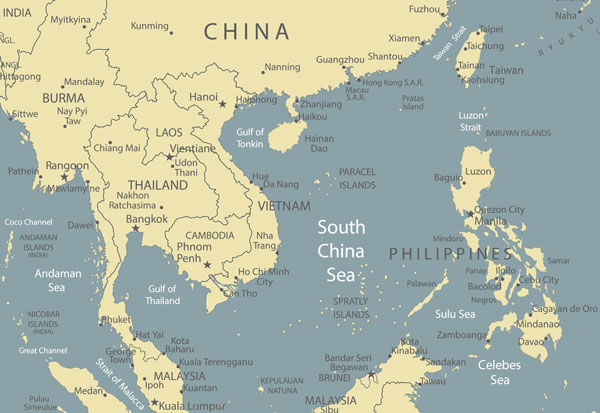Avascent First Person: Steve Ganyard on the Japanese Defense Outlook
About Steve Ganyard
Steve Ganyard (Colonel, USMC, Ret.) is an Avascent Principal and President of Avascent Global Advisors. Steve’s civilian and military career includes experience in a variety of high-level leadership, managerial and staff positions dealing with complex technologies, strategic planning, foreign policy, intelligence, homeland security and global operations.
At Avascent, he helps clients with international market strategy development and execution, political strategy and risk management, as well as business development and capture support. His primary focus is on Asian markets.
What are the main drivers of Japanese defense modernization right now?
As in most military modernization efforts, it’s the threat. Yet there are two different threats: the public and political perception threat of ballistic missiles from North Korea; and then there is the truer threat presented by China.
The policy staff in the Japanese Ministry of Defense (JMOD) and those who are responsible for policy at the National Security Strategy understand the China threat. They know China would be much more capable of some sort of a decapitation seizure or cut off of the Nansei Shoto than North Korea.
China presents a clear existential threat, North Korea less so. Thus the politicians react to North Korean missiles in a way that says that “we’ll protect the people and build a missile shield over large population centers like Tokyo” because they have to address public fears.
But spending on ballistic missile defense of population centers competing with the broader threat from China, which requires focusing on defense of the Southern Island Chain and defense of the southern reaches.
This has become all that much more critical as President Duterte in the Philippines begins to think about kicking the United States out, thus exposing Japan’s southern maritime trade routes.
With the Philippines’ President Rodrigo Duterte apparently pivoting the country away from the US, how does this impact the U.S.-Japan strategic alliance?
Hopefully it will make it stronger. When Duterte recently visited Tokyo, Prime Minister Abe said all the right things in terms of reinforcing Japan’s relationship with the U.S., as well as trying to calm him down a bit.
But if the U.S. gets kicked out of the Philippines then it leaves a strategic, geographic gap. That gap is essentially the South China Sea across from the Paracel and the Spratly Islands where the U.S. will have no basing and does not have the ability to ensure order in the way that it would if it has access to bases in the Philippines.
So it means that the U.S. really has a Northern Asia ally in Japan and a southern South Eastern Asian ally in Australia. But ne’r the two shall meet because the Australians are not going to come out of their own backyard and the Japanese aren’t either.
That leaves this large strategic gap for the United States between Japan and Australia to fill. But it’s obviously going to take new relationships that will in some ways mean that the U.S. is going to have to decrease the kind of support it offers Japan because it’s going to require a strategic stretch.
Where are the most acute geographic areas of concern for the Japanese Ministry of Defense?
One of things that the JMOD, and most Japanese strategic thinkers, understand is the criticality of the South China Sea and the $3 trillion or $5 trillion worth of trade that flows through the Philippines Channel and up through the Spratlys and the Paracels.
If the Philippines allow the Chinese to triangulate their holdings within that region and put fighter- and bomber-sized runways throughout the South China Sea, then this obviously creates a strategic choke point that the Japanese really aren’t going to be able to do too much about unless they fortify their southern reaches.
With the Philippines kicking us out it only makes matters worse because now the U.S. has no basing and no ability to directly oppose, on the other side of the South China Sea, any Chinese aggression. The way things are going it looks very likely that the Chinese will soon be able to easily control the southern reaches of Japan’s most critical trade routes.
Japan’s defense spending appears to have been growing since 2011, so what are the takeaways from the latest budget in terms of priorities but also the sustainability of it?
It’s Chinese agitprop that Japanese defense spending has increased. It’s been less than marginal and I think that if you look at the true numbers, all it does is take into account some increased personnel costs.
In terms of O&M (operations and maintenance) budget, you can claim that it is increasing – some of that is reflective of currency change fluctuations – but the idea that the Japanese defense budget is expanding doesn’t hold up. It could be argued that it has actually been contracting slightly in that deflation has taken its toll.
We recently saw data indicating year-over-year deflation of 0.4% in Japan. So in actuality what we’re seeing is a decreased Japanese defense budget and certainly not the cause for concern that the Chinese would have Japan’s neighbors believe. It’s more a concern for the U.S. because the strategic gap opened by the Philippines “pivot” could use Japanese help.
Where are the most acute geographic areas of concern for the Japanese Ministry of Defense?
One of things that the JMOD, and most Japanese strategic thinkers, understand is the criticality of the South China Sea and the $3 trillion or $5 trillion worth of trade that flows through the Philippines Channel and up through the Spratlys and the Paracels.
If the Philippines allow the Chinese to triangulate their holdings within that region and put fighter- and bomber-sized runways throughout the South China Sea, then this obviously creates a strategic choke point that the Japanese really aren’t going to be able to do too much about unless they fortify their southern reaches.
With the Philippines kicking us out it only makes matters worse because now the U.S. has no basing and no ability to directly oppose, on the other side of the South China Sea, any Chinese aggression. The way things are going it looks very likely that the Chinese will soon be able to easily control the southern reaches of Japan’s most critical trade routes.
Japan’s Defense Spending Appears To Have Been Growing Since 2011, So What Are The Takeaways From The Latest Budget In Terms Of Priorities But Also The Sustainability Of It? e?
It’s Chinese agitprop that Japanese defense spending has increased. It’s been less than marginal and I think that if you look at the true numbers, all it does is take into account some increased personnel costs.
In terms of O&M (operations and maintenance) budget, you can claim that it is increasing – some of that is reflective of currency change fluctuations – but the idea that the Japanese defense budget is expanding doesn’t hold up.
It could be argued that it has actually been contracting slightly in that deflation has taken its toll. We recently saw data indicating year-over-year deflation of 0.4% in Japan.
So in actuality what we’re seeing is a decreased Japanese defense budget and certainly not the cause for concern that the Chinese would have Japan’s neighbors believe. It’s more a concern for the U.S. because the strategic gap opened by the Philippines “pivot” could use Japanese help.
How Do You See The Threat Environment Evolving For Japan Vis A Vis China And North Korea?
There are a couple things that are happening: North Korea’s missile development program seems quite intent on developing a long-range, if not MRBM (medium range ballistic missile), then an ICBM (intercontinental ballistic missile) with nuclear delivery capability.
That threatens not just Northeast Asia but the U.S. as well. But so far our policies have been ineffective in halting it and that North Korean effort is going to continue on its technological march. The ability to directly threaten Tokyo with a nuclear weapon is generating a lot of domestic political concern.
From the Chinese threat perspective it’s the increasing capability, both in quality and quantity on the sea, undersea, and in the air, as well as next-generation weapons. One of the interesting things we heard discussed on a recent trip to the region that is just getting traction here in the U.S. is the WU series of Chinese hyper-velocity glide vehicles.
The implication for the Japanese is that it increases the kinds of defense capabilities that are required to “look up.” So all their spending and the U.S.’s spending on X-Band radars, Aegis and PAC-3, and follow-on systems, are going to have greater requirements for that capability.
These greater requirements to counter this high-altitude threat mean that something else is going to go lacking and it’s probably going to be the “look-down” capability required for cruise missile defense.
That said, the Japanese realize that China’s ability to launch hundreds, if not thousands, of cruise missiles at strategic elements within the Nansei Shoto chain means that they can almost bring Japan to its knees without much more than conventional cruise missiles.
Japan Is Exploring A F-2 Fighter Replacement, Worth As Much As $40 Billion; How Do You Expect That To Take Shape In Terms Of Indigenous Development, Imports Or Co-Development Partnerships?
They are in the RFI stage now and this RFI is probably more important than it is in any other competition around the world. The Japanese are actually asking for “what is the art and the science of the possible” so they can make a determination on what kind of airplane they want to build.
The Japanese will publicly acknowledge that they are looking for answers on what this hypothetical airplane ought to be. They are well aware that they do not have the indigenous capacity to develop a globally competitive fifth generation airplane: they haven’t even decided whether it’s manned or unmanned, or if it’s an air superiority fighter, or is it an all-singing, all-dancing kind of aircraft. A
s one Japanese observer told us in Tokyo recently, the F-3 will happen: it will happen because Japanese industry insists on the jobs and the technological defense industrial base maintenance. It may be ugly, it may take many years, but there will be an F-3, and it’s just a question of what level the U.S., or any other fighter maker in the world including Dassault and Saab, might be able to offer.
Obviously, low observable is a U.S. expertise but how much of that technology gets shared is a really question tied to whether Japan is going to get serious about defense industrial security. That failure to institute information and technology security protocols is the single largest impediment to improved U.S.-Japan cooperation, both militarily and between industry.
With Japan’s Next-Generation Fighter, Could There Be A Leap-Ahead Advancement With An Unmanned Platform?
It would have to find a niche that they currently haven’t shown any interest or capability in. So it would have do something better than anything that any other country would or could build. Right now they don’t have either the money or the technological background to be able to do that, so they are going to have to partner with some other outside firm or country to create something that is close enough for their purposes.
But again the key driver in all F-3 discussions is jobs and maintenance of a defense industrial base. The buys that they are making now with F-35s, the upgrades that will occur on the F-15 suite, those are threat driven. The F-3 is unique in that it is industrial-base driven.
Are There Past Or Current Japan-U.S. Defense Industrial Co-Development Models That Can Be Expanded Or Are We Likely To See New Partnerships For The Fighter Program?
The SM-3 Block IIA is held up as the model high technology relationship but in many ways that was just “you make one end and we’ll make the other.” It wasn’t a truly integrated system the way an aircraft would have to be and so although there have been good strides made in terms of how the relationship functions from a high technology industrial participation aspect, there’s still a long way to go for something as sophisticated as an entire airplane.
But that doesn’t mean that other opportunities can’t be found, Japan is very interested in finding a way to put money towards, and participate in, some part of the Third Offset strategy with key technologies they do well like robotics and AI. But in terms of conventional capabilities and being competitive in the global marketplace there’s not much likelihood that that will happen soon.
Whether The Third Offset Strategy Changes Evolves Or Not With The Next U.S. Administration, What Role Do You See Japanese Industry And The JMOD Having In The Defense Department’s Quest For Game-Changing Defense Technologies?
The important thing to remember here is that Japanese industry is very different from U.S. or European industry in that they don’t lead with technology globally because they don’t have the internal R&D funds that most other firms do – all because they have not exported in the recent past and so have no revenue margins for IRAD investment.
They tend to be given build-to-print to government requirements, which are doled out in a way so as to preserve Japanese jobs and the defense industrial base. So it’s a very managed system that ensures jobs but eschews competition.
Which means that most of their indigenous products are not globally competitive. If there are going to be initiatives taken in terms of high technology, it’s going to have to come from the government itself.
The government has said they want to find ways that they can invest in Third Offset-like technologies but they want to do it with the United States. And the funding for those sorts of initiatives will only come from the Japanese government, not Japanese industry.







